
spaCy
💫 Industrial-strength Natural Language Processing (NLP) in Python
Stars: 30652
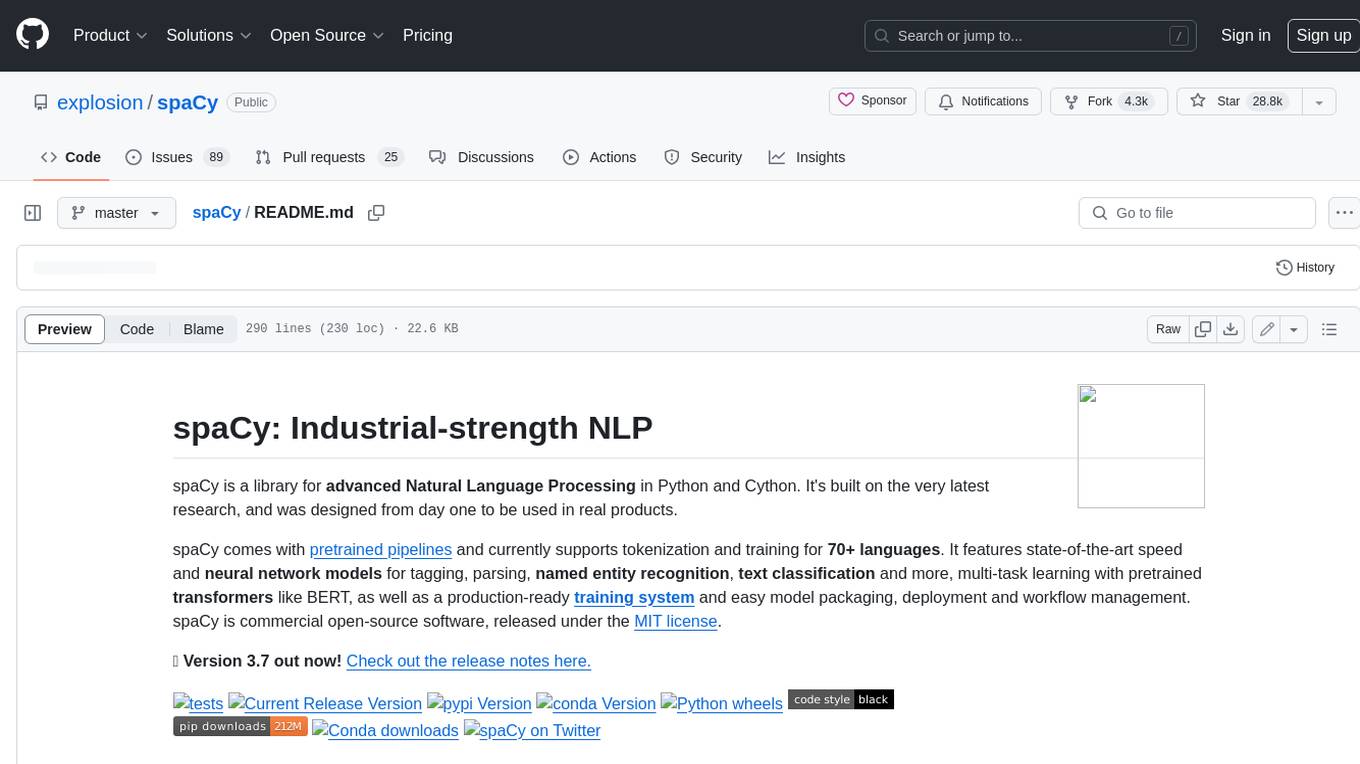
spaCy is an industrial-strength Natural Language Processing (NLP) library in Python and Cython. It incorporates the latest research and is designed for real-world applications. The library offers pretrained pipelines supporting 70+ languages, with advanced neural network models for tasks such as tagging, parsing, named entity recognition, and text classification. It also facilitates multi-task learning with pretrained transformers like BERT, along with a production-ready training system and streamlined model packaging, deployment, and workflow management. spaCy is commercial open-source software released under the MIT license.
README:
spaCy is a library for advanced Natural Language Processing in Python and Cython. It's built on the very latest research, and was designed from day one to be used in real products.
spaCy comes with pretrained pipelines and currently supports tokenization and training for 70+ languages. It features state-of-the-art speed and neural network models for tagging, parsing, named entity recognition, text classification and more, multi-task learning with pretrained transformers like BERT, as well as a production-ready training system and easy model packaging, deployment and workflow management. spaCy is commercial open-source software, released under the MIT license.
💫 Version 3.7 out now! Check out the release notes here.
| Documentation | |
|---|---|
| ⭐️ spaCy 101 | New to spaCy? Here's everything you need to know! |
| 📚 Usage Guides | How to use spaCy and its features. |
| 🚀 New in v3.0 | New features, backwards incompatibilities and migration guide. |
| 🪐 Project Templates | End-to-end workflows you can clone, modify and run. |
| 🎛 API Reference | The detailed reference for spaCy's API. |
| ⏩ GPU Processing | Use spaCy with CUDA-compatible GPU processing. |
| 📦 Models | Download trained pipelines for spaCy. |
| 🦙 Large Language Models | Integrate LLMs into spaCy pipelines. |
| 🌌 Universe | Plugins, extensions, demos and books from the spaCy ecosystem. |
| ⚙️ spaCy VS Code Extension | Additional tooling and features for working with spaCy's config files. |
| 👩🏫 Online Course | Learn spaCy in this free and interactive online course. |
| 📰 Blog | Read about current spaCy and Prodigy development, releases, talks and more from Explosion. |
| 📺 Videos | Our YouTube channel with video tutorials, talks and more. |
| 🛠 Changelog | Changes and version history. |
| 💝 Contribute | How to contribute to the spaCy project and code base. |
| 👕 Swag | Support us and our work with unique, custom-designed swag! |
| Custom NLP consulting, implementation and strategic advice by spaCy’s core development team. Streamlined, production-ready, predictable and maintainable. Send us an email or take our 5-minute questionnaire, and well'be in touch! Learn more → |
The spaCy project is maintained by the spaCy team. Please understand that we won't be able to provide individual support via email. We also believe that help is much more valuable if it's shared publicly, so that more people can benefit from it.
| Type | Platforms |
|---|---|
| 🚨 Bug Reports | GitHub Issue Tracker |
| 🎁 Feature Requests & Ideas | GitHub Discussions |
| 👩💻 Usage Questions | GitHub Discussions · Stack Overflow |
| 🗯 General Discussion | GitHub Discussions |
- Support for 70+ languages
- Trained pipelines for different languages and tasks
- Multi-task learning with pretrained transformers like BERT
- Support for pretrained word vectors and embeddings
- State-of-the-art speed
- Production-ready training system
- Linguistically-motivated tokenization
- Components for named entity recognition, part-of-speech-tagging, dependency parsing, sentence segmentation, text classification, lemmatization, morphological analysis, entity linking and more
- Easily extensible with custom components and attributes
- Support for custom models in PyTorch, TensorFlow and other frameworks
- Built in visualizers for syntax and NER
- Easy model packaging, deployment and workflow management
- Robust, rigorously evaluated accuracy
📖 For more details, see the facts, figures and benchmarks.
For detailed installation instructions, see the documentation.
- Operating system: macOS / OS X · Linux · Windows (Cygwin, MinGW, Visual Studio)
- Python version: Python 3.7+ (only 64 bit)
-
Package managers: pip · conda (via
conda-forge)
Using pip, spaCy releases are available as source packages and binary wheels.
Before you install spaCy and its dependencies, make sure that your pip,
setuptools and wheel are up to date.
pip install -U pip setuptools wheel
pip install spacyTo install additional data tables for lemmatization and normalization you can
run pip install spacy[lookups] or install
spacy-lookups-data
separately. The lookups package is needed to create blank models with
lemmatization data, and to lemmatize in languages that don't yet come with
pretrained models and aren't powered by third-party libraries.
When using pip it is generally recommended to install packages in a virtual environment to avoid modifying system state:
python -m venv .env
source .env/bin/activate
pip install -U pip setuptools wheel
pip install spacyYou can also install spaCy from conda via the conda-forge channel. For the
feedstock including the build recipe and configuration, check out
this repository.
conda install -c conda-forge spacySome updates to spaCy may require downloading new statistical models. If you're
running spaCy v2.0 or higher, you can use the validate command to check if
your installed models are compatible and if not, print details on how to update
them:
pip install -U spacy
python -m spacy validateIf you've trained your own models, keep in mind that your training and runtime inputs must match. After updating spaCy, we recommend retraining your models with the new version.
📖 For details on upgrading from spaCy 2.x to spaCy 3.x, see the migration guide.
Trained pipelines for spaCy can be installed as Python packages. This means
that they're a component of your application, just like any other module. Models
can be installed using spaCy's download
command, or manually by pointing pip to a path or URL.
| Documentation | |
|---|---|
| Available Pipelines | Detailed pipeline descriptions, accuracy figures and benchmarks. |
| Models Documentation | Detailed usage and installation instructions. |
| Training | How to train your own pipelines on your data. |
# Download best-matching version of specific model for your spaCy installation
python -m spacy download en_core_web_sm
# pip install .tar.gz archive or .whl from path or URL
pip install /Users/you/en_core_web_sm-3.0.0.tar.gz
pip install /Users/you/en_core_web_sm-3.0.0-py3-none-any.whl
pip install https://github.com/explosion/spacy-models/releases/download/en_core_web_sm-3.0.0/en_core_web_sm-3.0.0.tar.gzTo load a model, use spacy.load()
with the model name or a path to the model data directory.
import spacy
nlp = spacy.load("en_core_web_sm")
doc = nlp("This is a sentence.")You can also import a model directly via its full name and then call its
load() method with no arguments.
import spacy
import en_core_web_sm
nlp = en_core_web_sm.load()
doc = nlp("This is a sentence.")📖 For more info and examples, check out the models documentation.
The other way to install spaCy is to clone its GitHub repository and build it from source. That is the common way if you want to make changes to the code base. You'll need to make sure that you have a development environment consisting of a Python distribution including header files, a compiler, pip, virtualenv and git installed. The compiler part is the trickiest. How to do that depends on your system.
| Platform | |
|---|---|
| Ubuntu | Install system-level dependencies via apt-get: sudo apt-get install build-essential python-dev git . |
| Mac | Install a recent version of XCode, including the so-called "Command Line Tools". macOS and OS X ship with Python and git preinstalled. |
| Windows | Install a version of the Visual C++ Build Tools or Visual Studio Express that matches the version that was used to compile your Python interpreter. |
For more details and instructions, see the documentation on compiling spaCy from source and the quickstart widget to get the right commands for your platform and Python version.
git clone https://github.com/explosion/spaCy
cd spaCy
python -m venv .env
source .env/bin/activate
# make sure you are using the latest pip
python -m pip install -U pip setuptools wheel
pip install -r requirements.txt
pip install --no-build-isolation --editable .To install with extras:
pip install --no-build-isolation --editable .[lookups,cuda102]spaCy comes with an extensive test suite. In order to run the
tests, you'll usually want to clone the repository and build spaCy from source.
This will also install the required development dependencies and test utilities
defined in the requirements.txt.
Alternatively, you can run pytest on the tests from within the installed
spacy package. Don't forget to also install the test utilities via spaCy's
requirements.txt:
pip install -r requirements.txt
python -m pytest --pyargs spacyFor Tasks:
Click tags to check more tools for each tasksFor Jobs:
Alternative AI tools for spaCy
Similar Open Source Tools

spaCy
spaCy is an industrial-strength Natural Language Processing (NLP) library in Python and Cython. It incorporates the latest research and is designed for real-world applications. The library offers pretrained pipelines supporting 70+ languages, with advanced neural network models for tasks such as tagging, parsing, named entity recognition, and text classification. It also facilitates multi-task learning with pretrained transformers like BERT, along with a production-ready training system and streamlined model packaging, deployment, and workflow management. spaCy is commercial open-source software released under the MIT license.
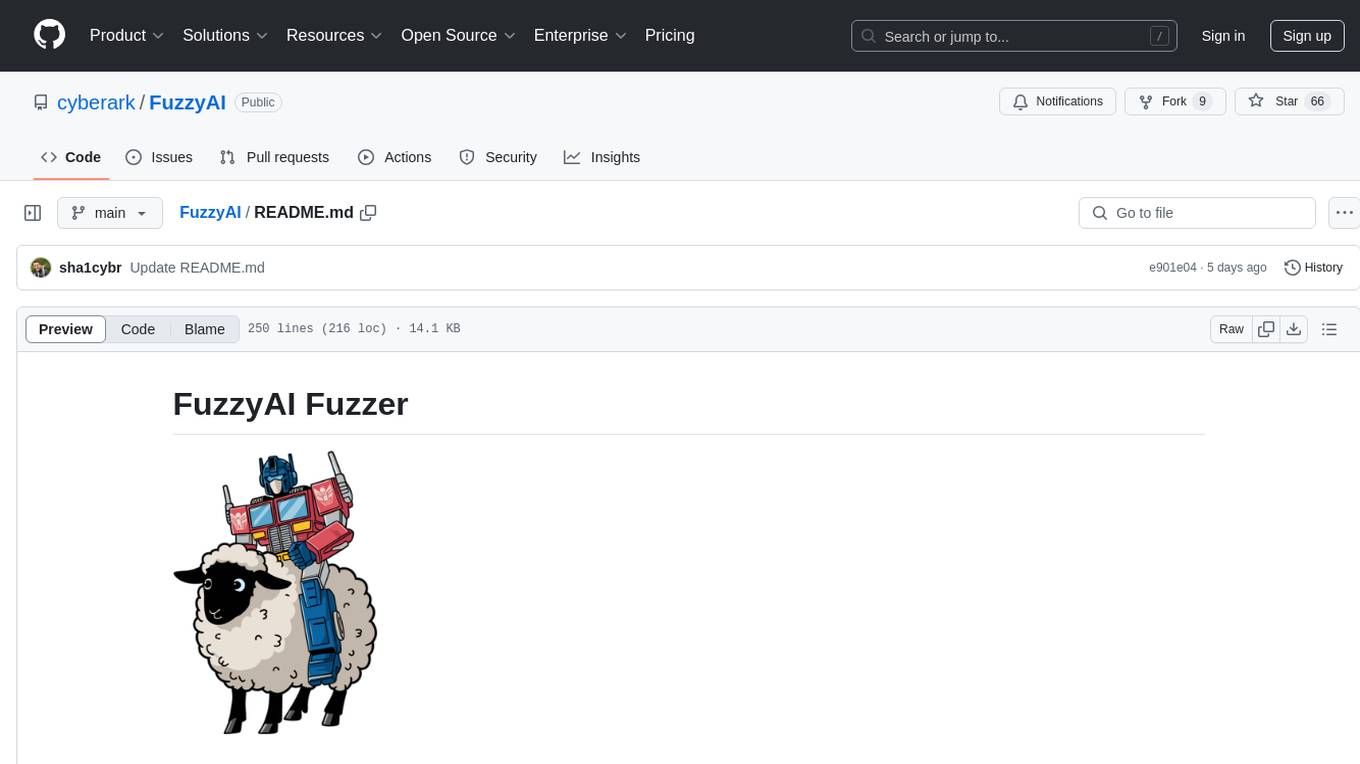
FuzzyAI
The FuzzyAI Fuzzer is a powerful tool for automated LLM fuzzing, designed to help developers and security researchers identify jailbreaks and mitigate potential security vulnerabilities in their LLM APIs. It supports various fuzzing techniques, provides input generation capabilities, can be easily integrated into existing workflows, and offers an extensible architecture for customization and extension. The tool includes attacks like ArtPrompt, Taxonomy-based paraphrasing, Many-shot jailbreaking, Genetic algorithm, Hallucinations, DAN (Do Anything Now), WordGame, Crescendo, ActorAttack, Back To The Past, Please, Thought Experiment, and Default. It supports models from providers like Anthropic, OpenAI, Gemini, Azure, Bedrock, AI21, and Ollama, with the ability to add support for newer models. The tool also supports various cloud APIs and datasets for testing and experimentation.
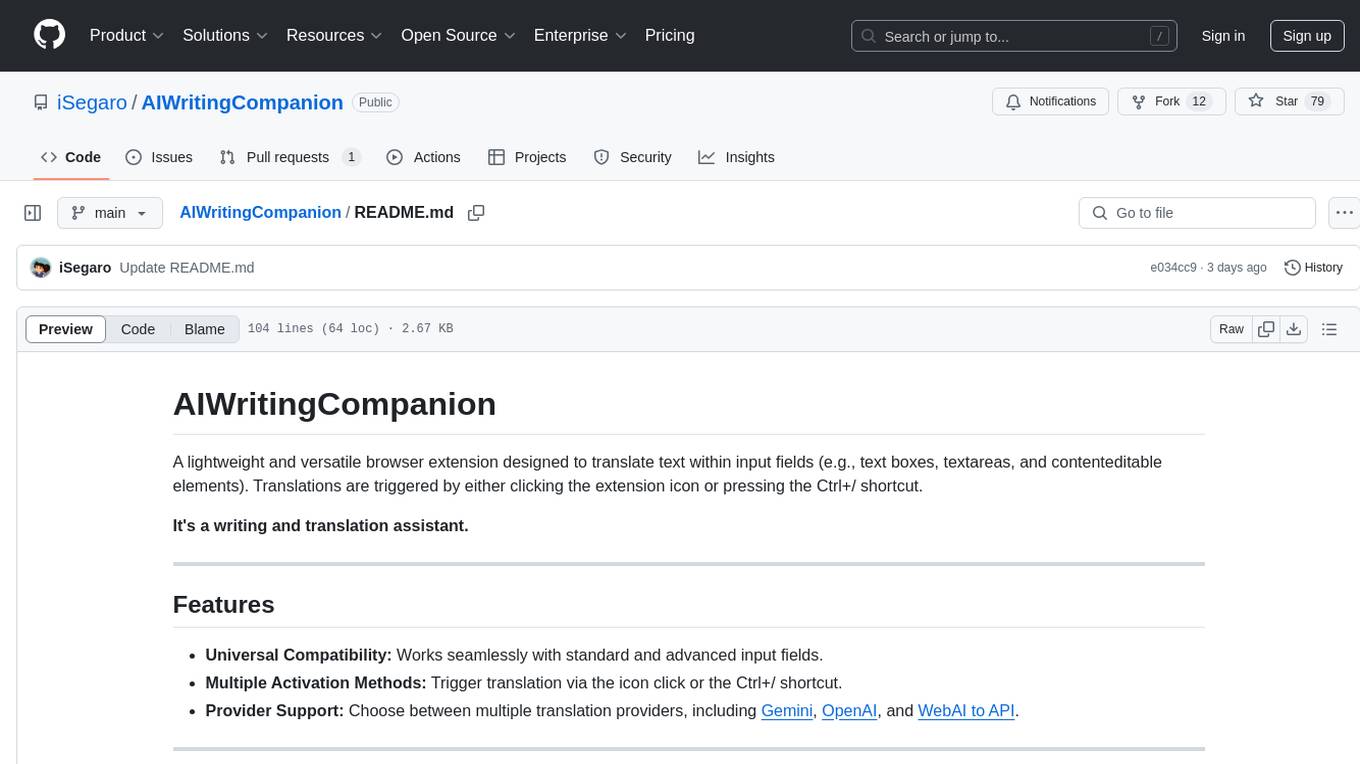
AIWritingCompanion
AIWritingCompanion is a lightweight and versatile browser extension designed to translate text within input fields. It offers universal compatibility, multiple activation methods, and support for various translation providers like Gemini, OpenAI, and WebAI to API. Users can install it via CRX file or Git, set API key, and use it for automatic translation or via shortcut. The tool is suitable for writers, translators, students, researchers, and bloggers. AI keywords include writing assistant, translation tool, browser extension, language translation, and text translator. Users can use it for tasks like translate text, assist in writing, simplify content, check language accuracy, and enhance communication.
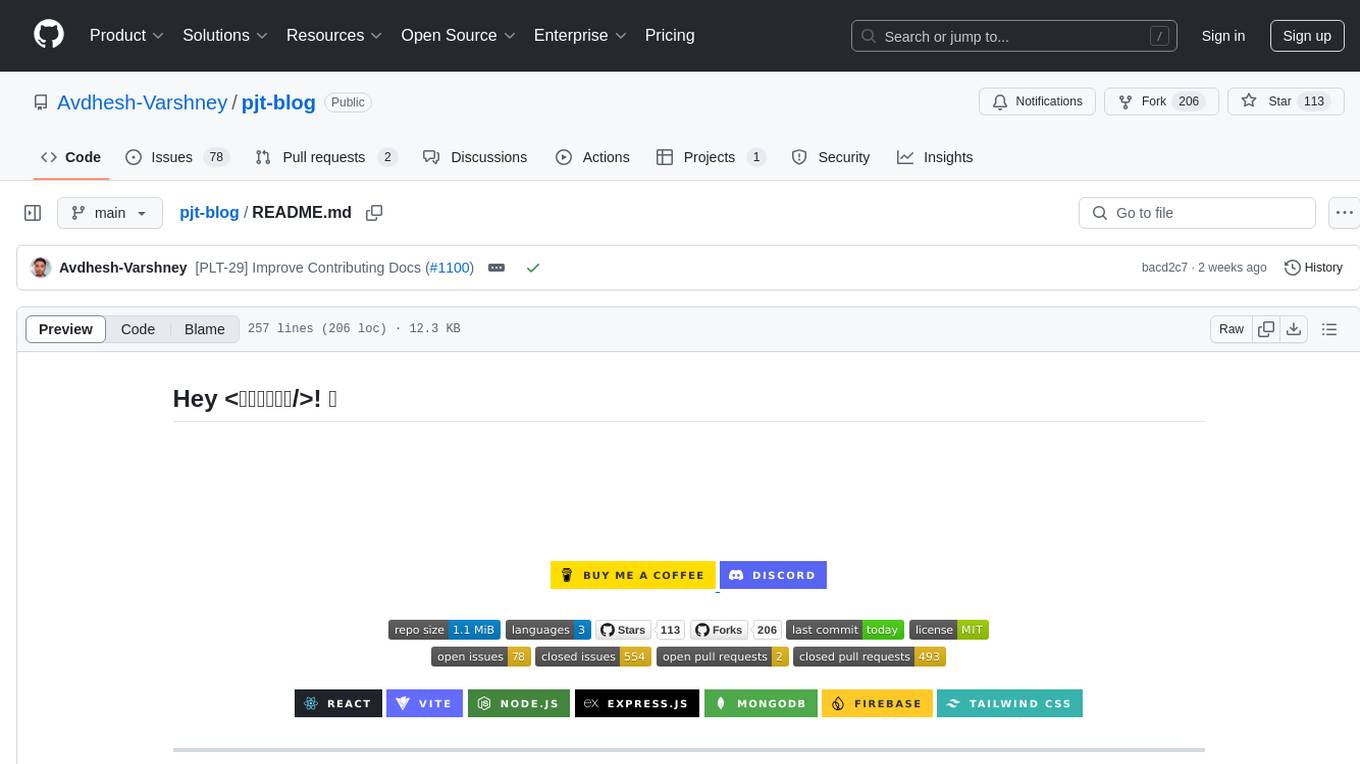
project-blog
Welcome to the Blog Script Project, a collaborative platform for developers and writers to create, manage, and share content. With features like Markdown support, submodule integration, customizable templates, project contribution workflow, global visibility, community discussions, SEO optimization, and role-based dashboard, Blog Script enhances collaboration and visibility for your work. You can contribute by adding new projects, improving existing projects, updating documentation, fixing bugs, optimizing, and ensuring code readability. Follow the contribution guidelines to star the repository, find tasks, fork the repository, make changes, add screenshots, submit a pull request, and contribute to the open-source community. Additionally, you can add your project as a submodule by following the provided guidelines. Join us, contribute, and grow together!
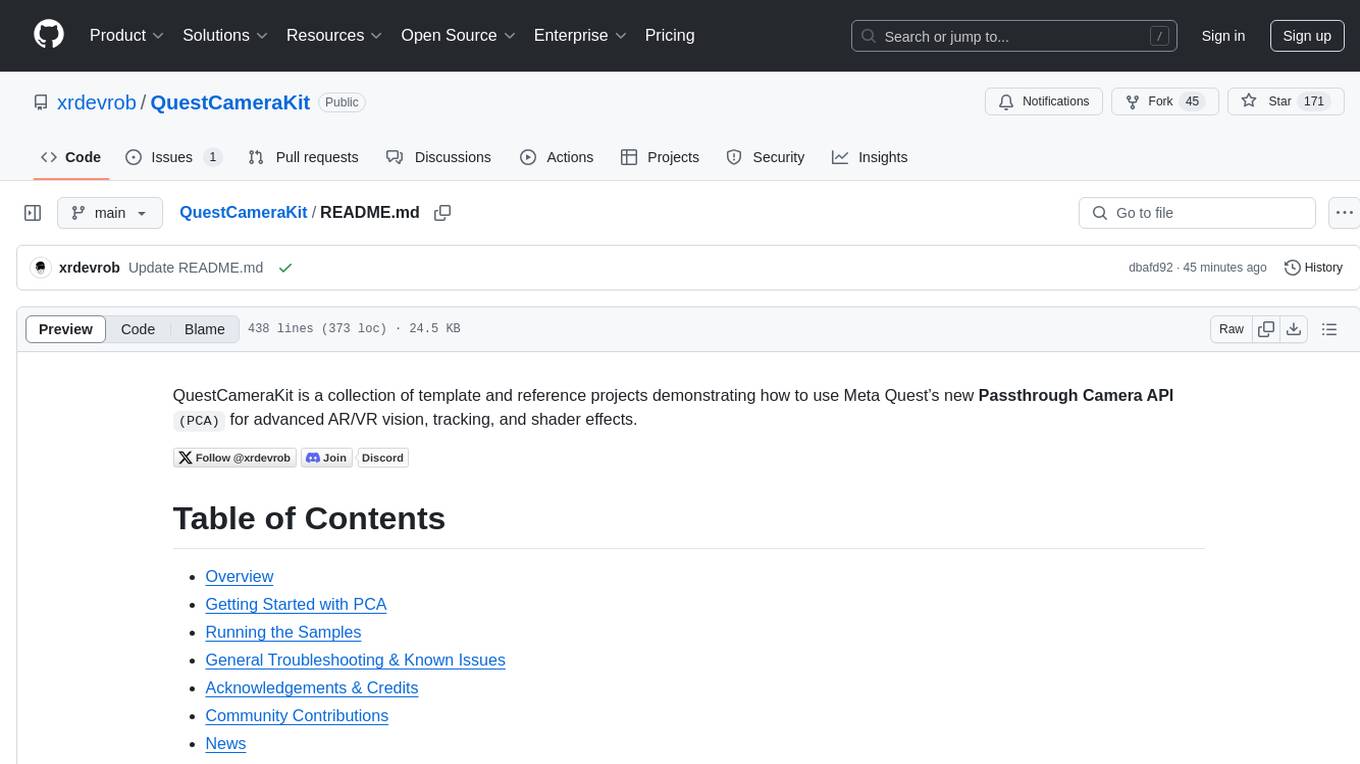
QuestCameraKit
QuestCameraKit is a collection of template and reference projects demonstrating how to use Meta Quest’s new Passthrough Camera API (PCA) for advanced AR/VR vision, tracking, and shader effects. It includes samples like Color Picker, Object Detection with Unity Sentis, QR Code Tracking with ZXing, Frosted Glass Shader, OpenAI vision model, and WebRTC video streaming. The repository provides detailed instructions on how to run each sample and troubleshoot known issues. Users can explore various functionalities such as converting 3D points to 2D image pixels, detecting objects, tracking QR codes, applying custom shader effects, interacting with OpenAI's vision model, and streaming camera feed over WebRTC.
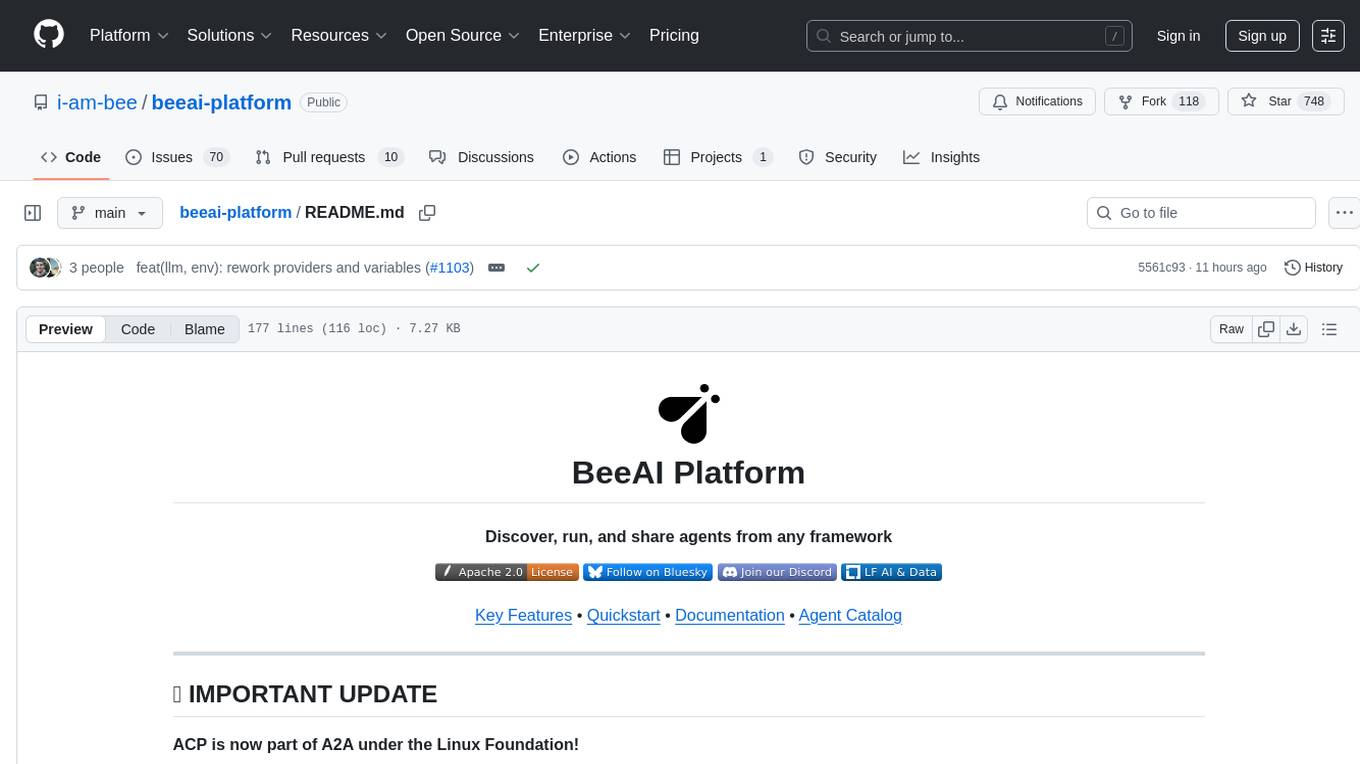
beeai-platform
BeeAI is an open-source platform that simplifies the discovery, running, and sharing of AI agents across different frameworks. It addresses challenges such as framework fragmentation, deployment complexity, and discovery issues by providing a standardized platform for individuals and teams to access agents easily. With features like a centralized agent catalog, framework-agnostic interfaces, containerized agents, and consistent user experiences, BeeAI aims to streamline the process of working with AI agents for both developers and teams.
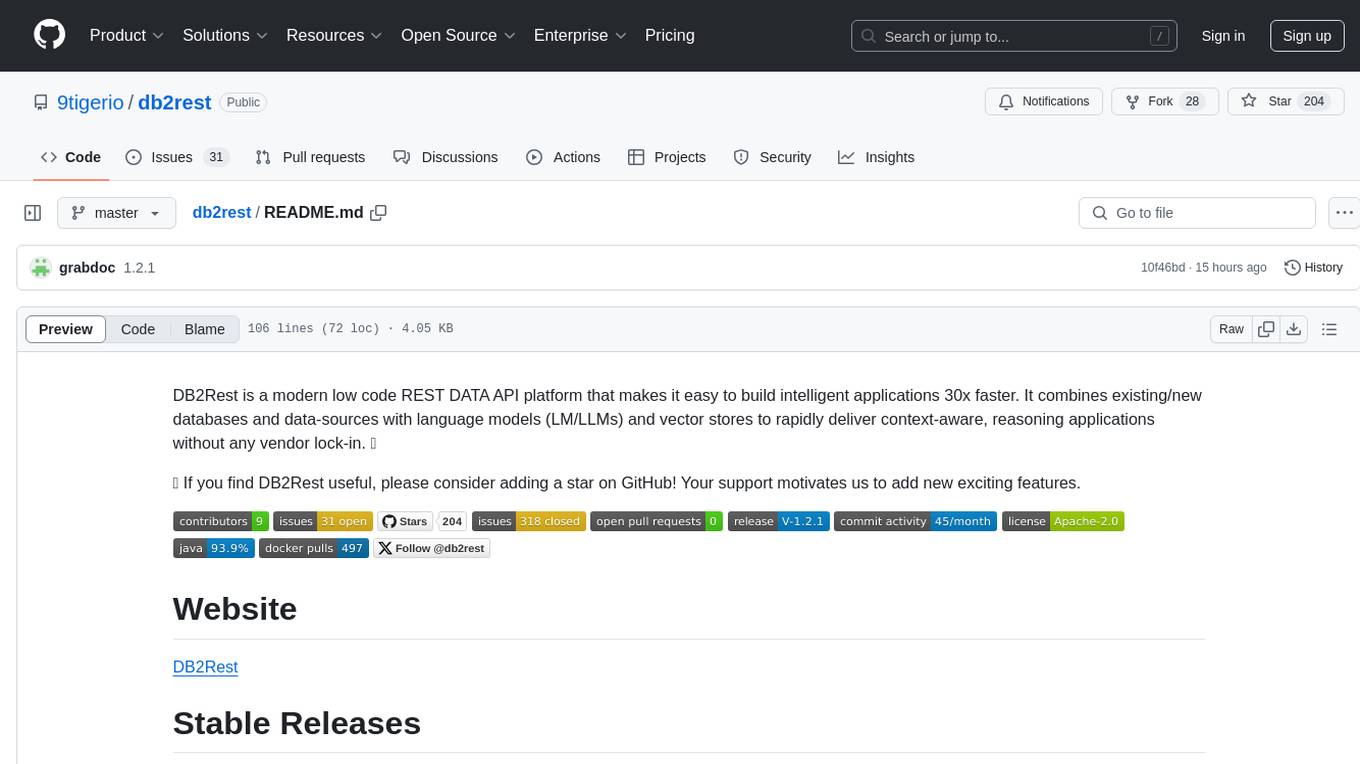
db2rest
DB2Rest is a modern low code REST DATA API platform that enables the rapid development of intelligent applications by combining databases, language models, and vector stores. It facilitates context-aware, reasoning applications without vendor lock-in. The tool accelerates application delivery, fosters faster innovation with AI, serves as a secure database gateway, and simplifies integration. It supports various databases like PostgreSQL, MySQL, MS SQL Server, Oracle, MongoDB, and more, with planned support for additional databases. Users can connect on Discord for support and contact [email protected] for inquiries.
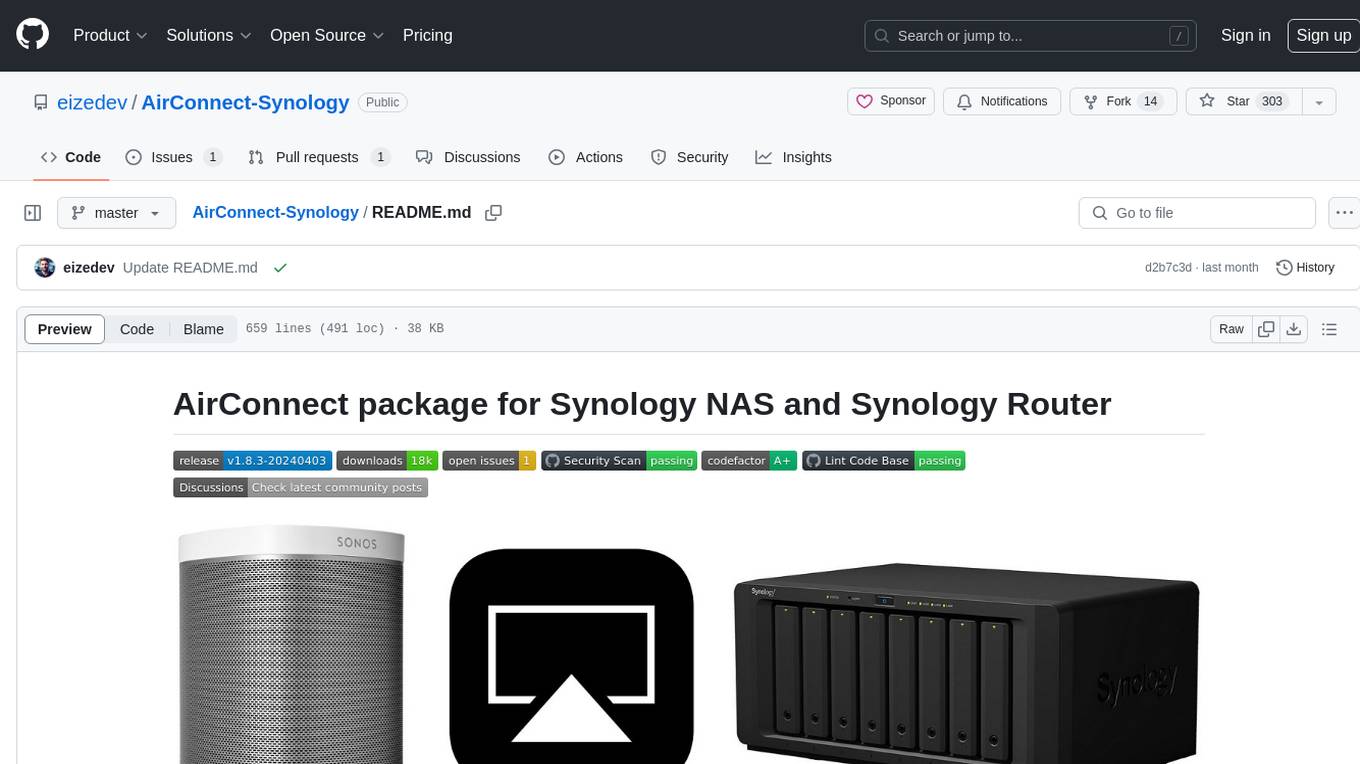
AirConnect-Synology
AirConnect-Synology is a minimal Synology package that allows users to use AirPlay to stream to UPnP/Sonos & Chromecast devices that do not natively support AirPlay. It is compatible with DSM 7.0 and DSM 7.1, and provides detailed information on installation, configuration, supported devices, troubleshooting, and more. The package automates the installation and usage of AirConnect on Synology devices, ensuring compatibility with various architectures and firmware versions. Users can customize the configuration using the airconnect.conf file and adjust settings for specific speakers like Sonos, Bose SoundTouch, and Pioneer/Phorus/Play-Fi.
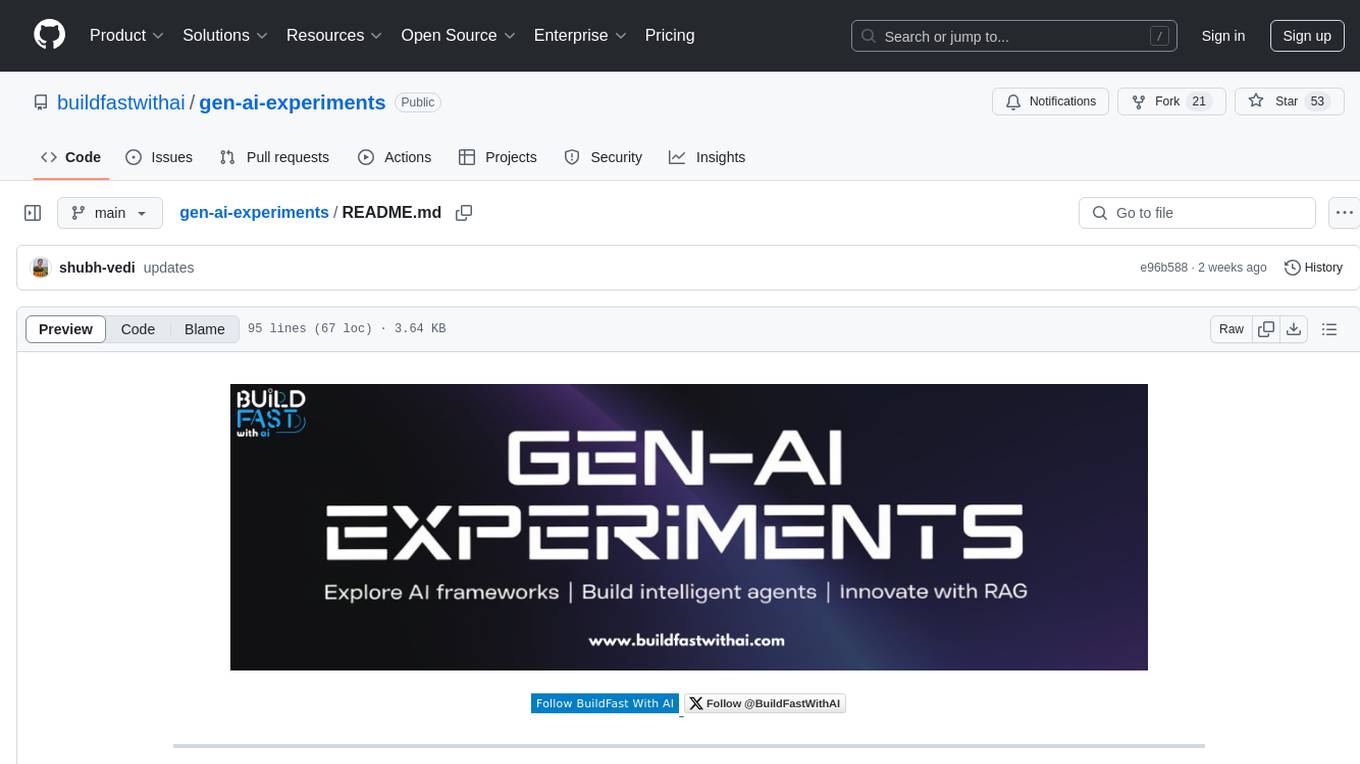
gen-ai-experiments
Gen-AI-Experiments is a structured collection of Jupyter notebooks and AI experiments designed to guide users through various AI tools, frameworks, and models. It offers valuable resources for both beginners and experienced practitioners, covering topics such as AI agents, model testing, RAG systems, real-world applications, and open-source tools. The repository includes folders with curated libraries, AI agents, experiments, LLM testing, open-source libraries, RAG experiments, and educhain experiments, each focusing on different aspects of AI development and application.
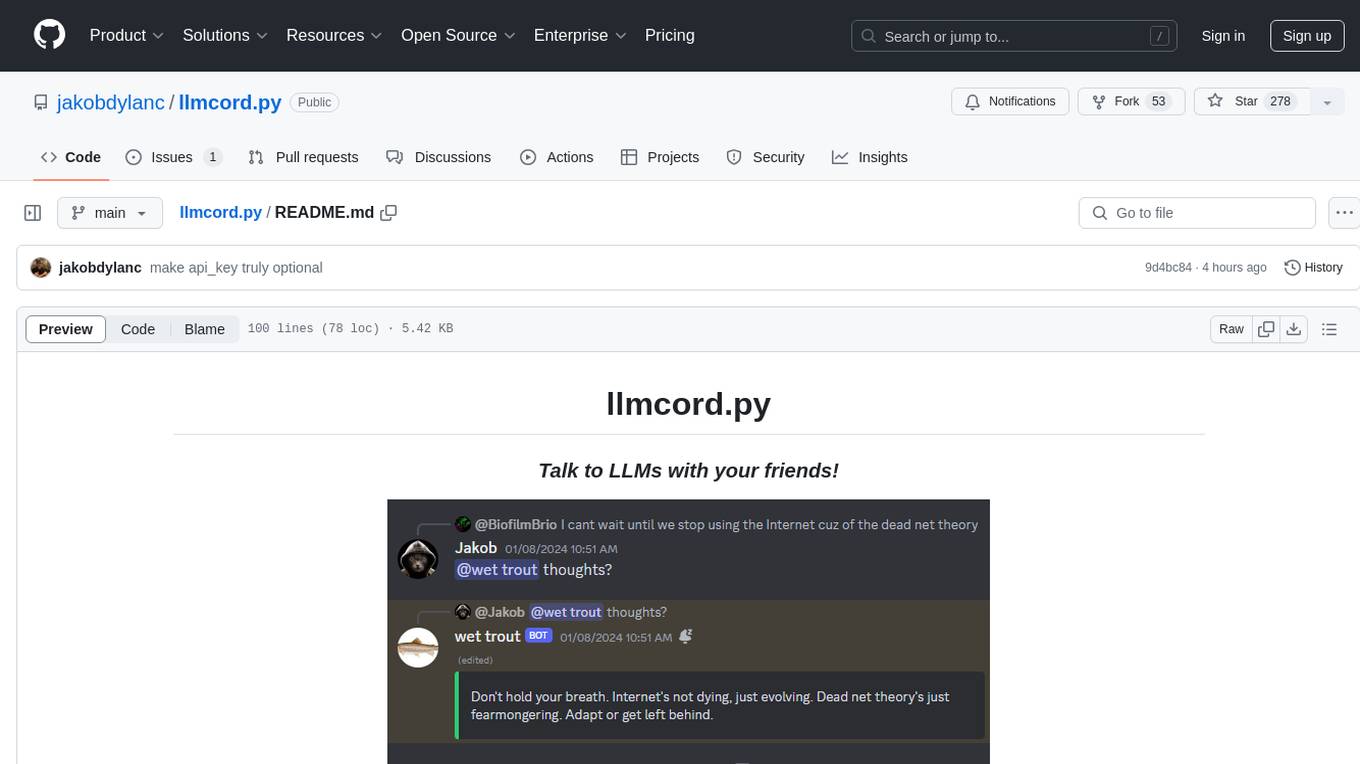
llmcord.py
llmcord.py is a tool that allows users to chat with Language Model Models (LLMs) directly in Discord. It supports various LLM providers, both remote and locally hosted, and offers features like reply-based chat system, choosing any LLM, support for image and text file attachments, customizable system prompt, private access via DM, user identity awareness, streamed responses, warning messages, efficient message data caching, and asynchronous operation. The tool is designed to facilitate seamless conversations with LLMs and enhance user experience on Discord.
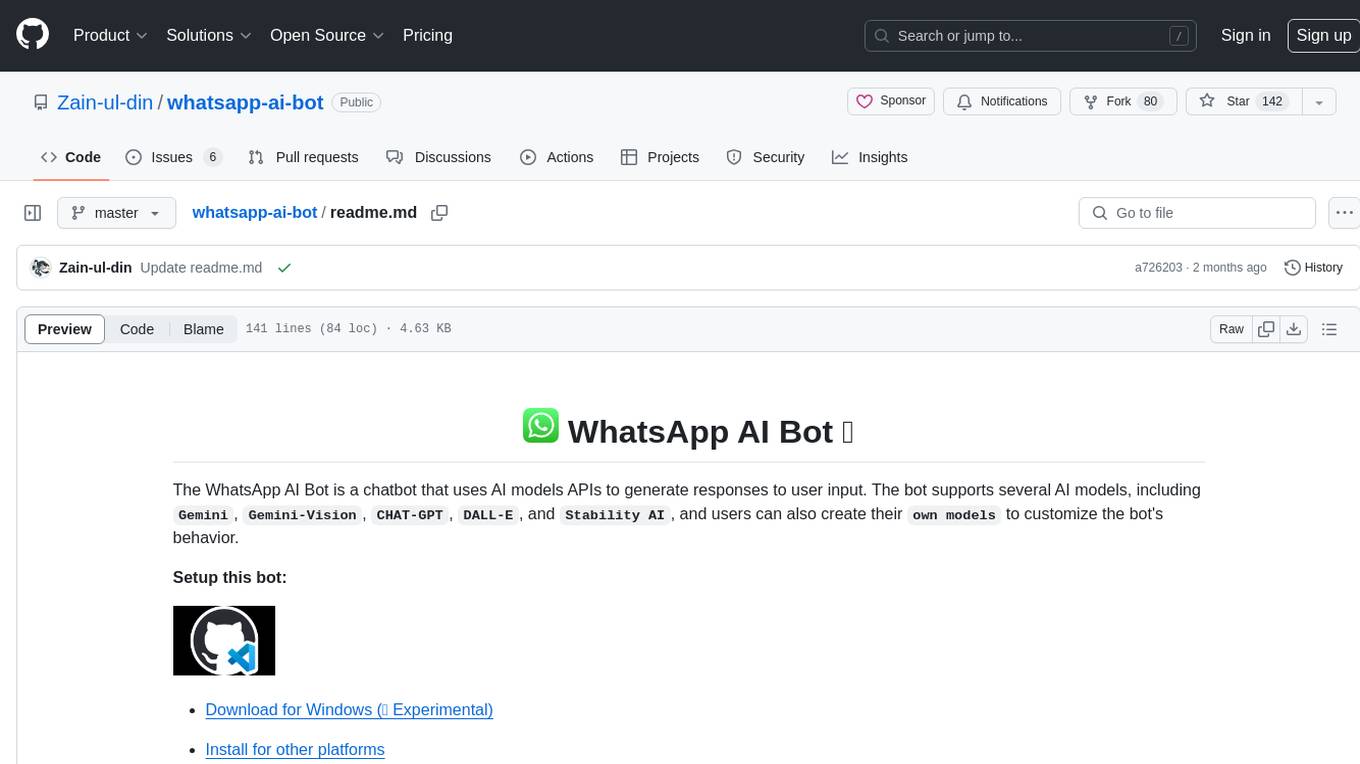
whatsapp-ai-bot
The WhatsApp AI Bot is a chatbot that utilizes various AI models APIs to generate responses to user input. Users can interact with the bot using commands to access different AI models such as Gemini, Gemini-Vision, CHAT-GPT, DALL-E, and Stability AI. Additionally, users have the flexibility to create their own custom models to personalize the bot's behavior. The bot operates on WhatsApp Web through Puppeteer and requires API keys for Gemini, OpenAI, and StabilityAI. It provides a range of functionalities and customization options for users interested in AI-powered chatbots.
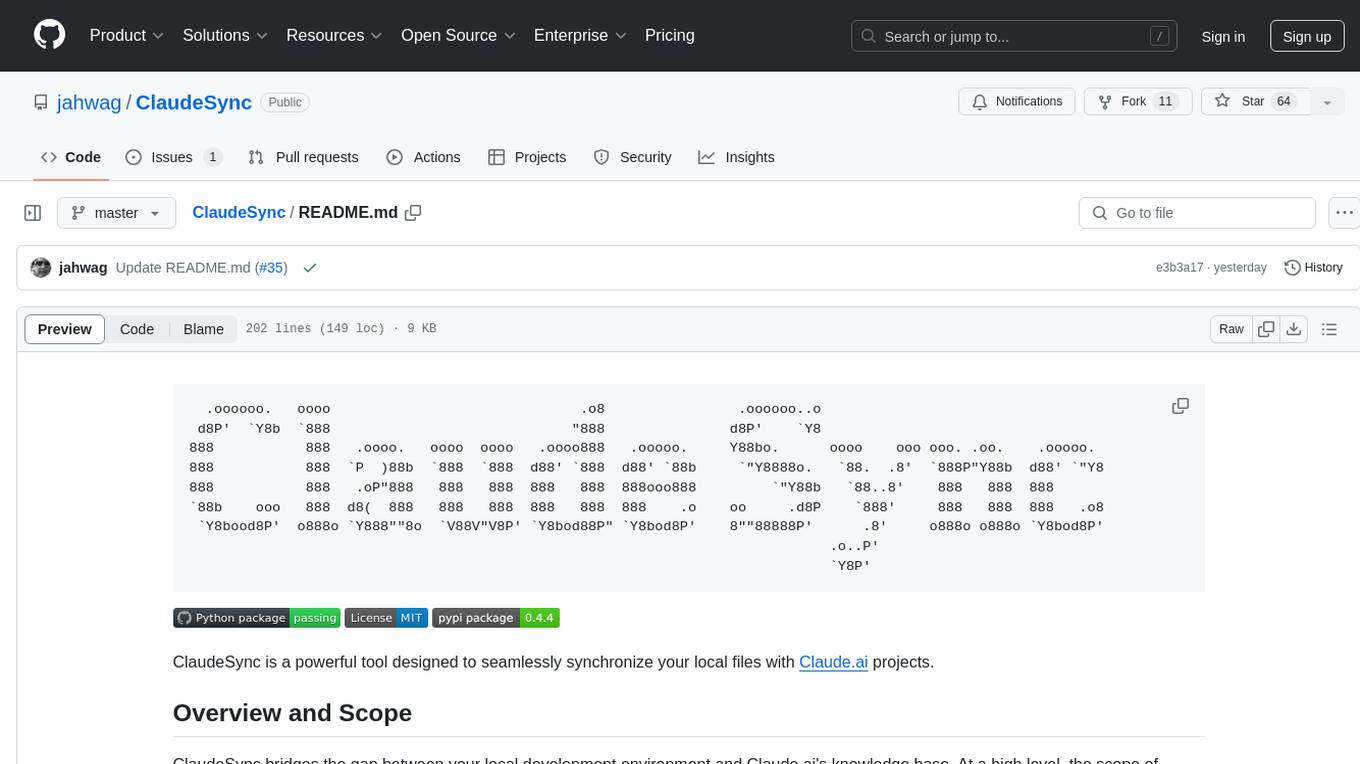
ClaudeSync
ClaudeSync is a powerful tool designed to seamlessly synchronize local files with Claude.ai projects. It bridges the gap between local development environment and Claude.ai's knowledge base, offering real-time synchronization, CLI for easy management, support for multiple organizations and projects, intelligent file filtering, configurable sync interval, two-way synchronization, and more. It ensures data privacy, open source transparency, and comes with disclaimers for use at own risk. Users can quickly start syncing by installing, logging in, selecting organization and project, and running sync. Advanced features include API, organization, project, file, chat management, configuration, synchronization modes, scheduled sync, providers, custom ignore file, and troubleshooting. Contributions are welcome, and communication channels include GitHub Issues and Discord. Licensed under MIT License.
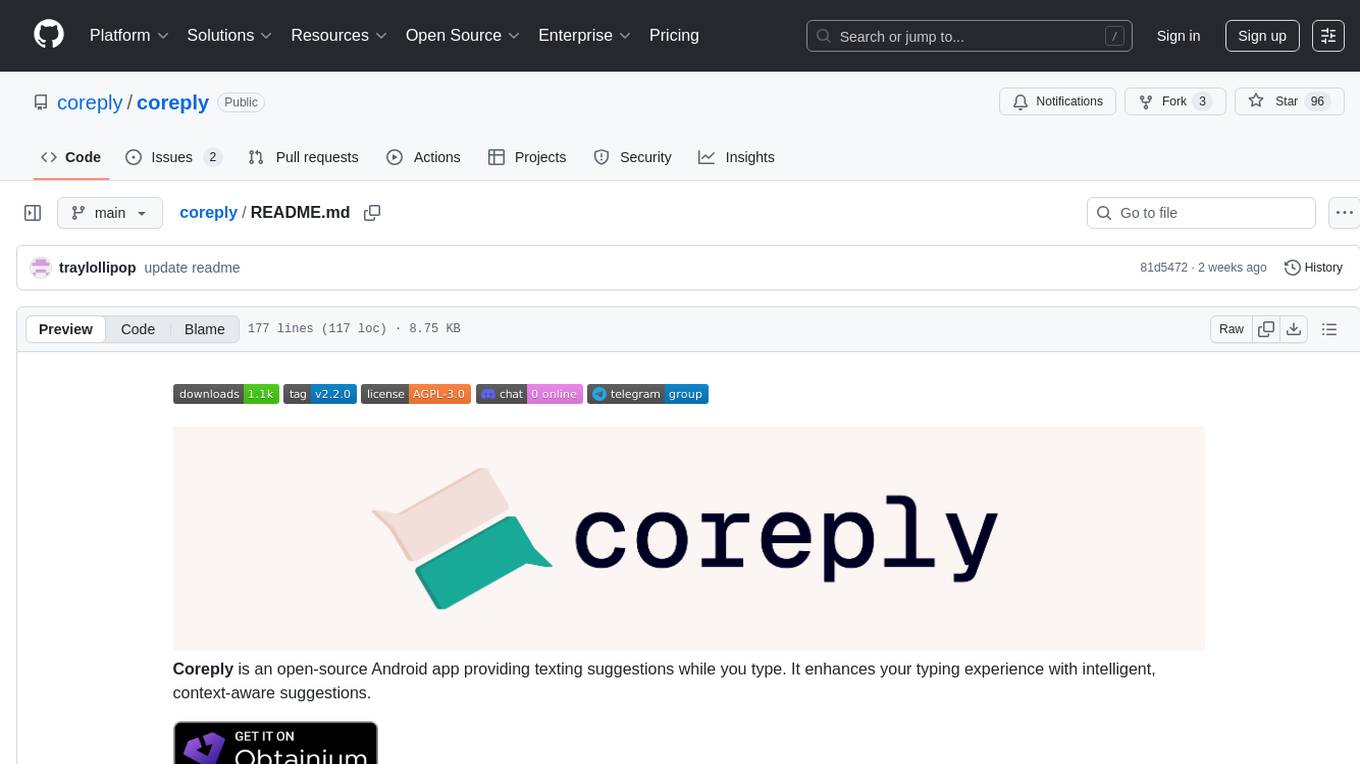
coreply
Coreply is an open-source Android app that provides texting suggestions while typing, enhancing the typing experience with intelligent, context-aware suggestions. It supports various texting apps and offers real-time AI suggestions, customizable LLM settings, and ensures no data collection. Users can install the app, configure it with an API key, and start receiving suggestions while typing in messaging apps. The tool supports different AI models from providers like OpenAI, Google AI Studio, Openrouter, Groq, and Codestral for chat completion and fill-in-the-middle tasks.
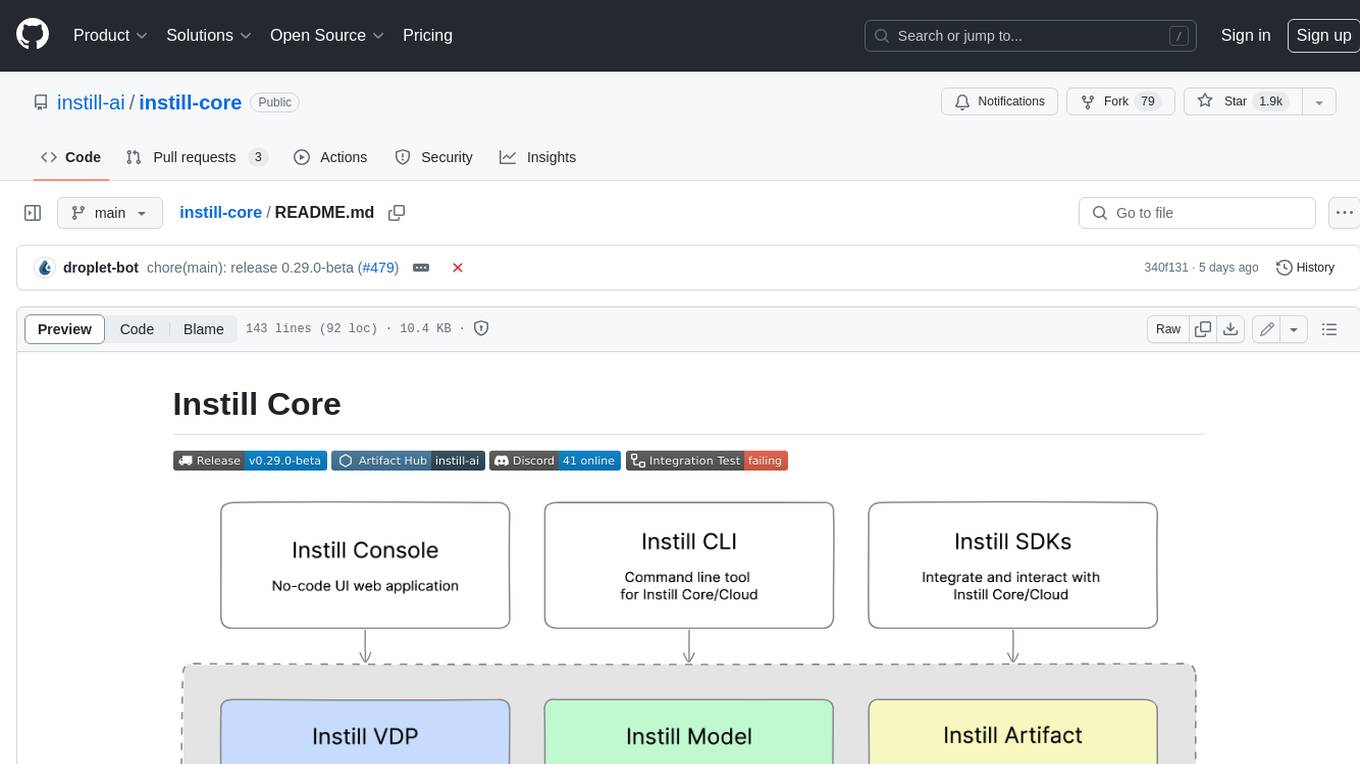
instill-core
Instill Core is an open-source orchestrator comprising a collection of source-available projects designed to streamline every aspect of building versatile AI features with unstructured data. It includes Instill VDP (Versatile Data Pipeline) for unstructured data, AI, and pipeline orchestration, Instill Model for scalable MLOps and LLMOps for open-source or custom AI models, and Instill Artifact for unified unstructured data management. Instill Core can be used for tasks such as building, testing, and sharing pipelines, importing, serving, fine-tuning, and monitoring ML models, and transforming documents, images, audio, and video into a unified AI-ready format.
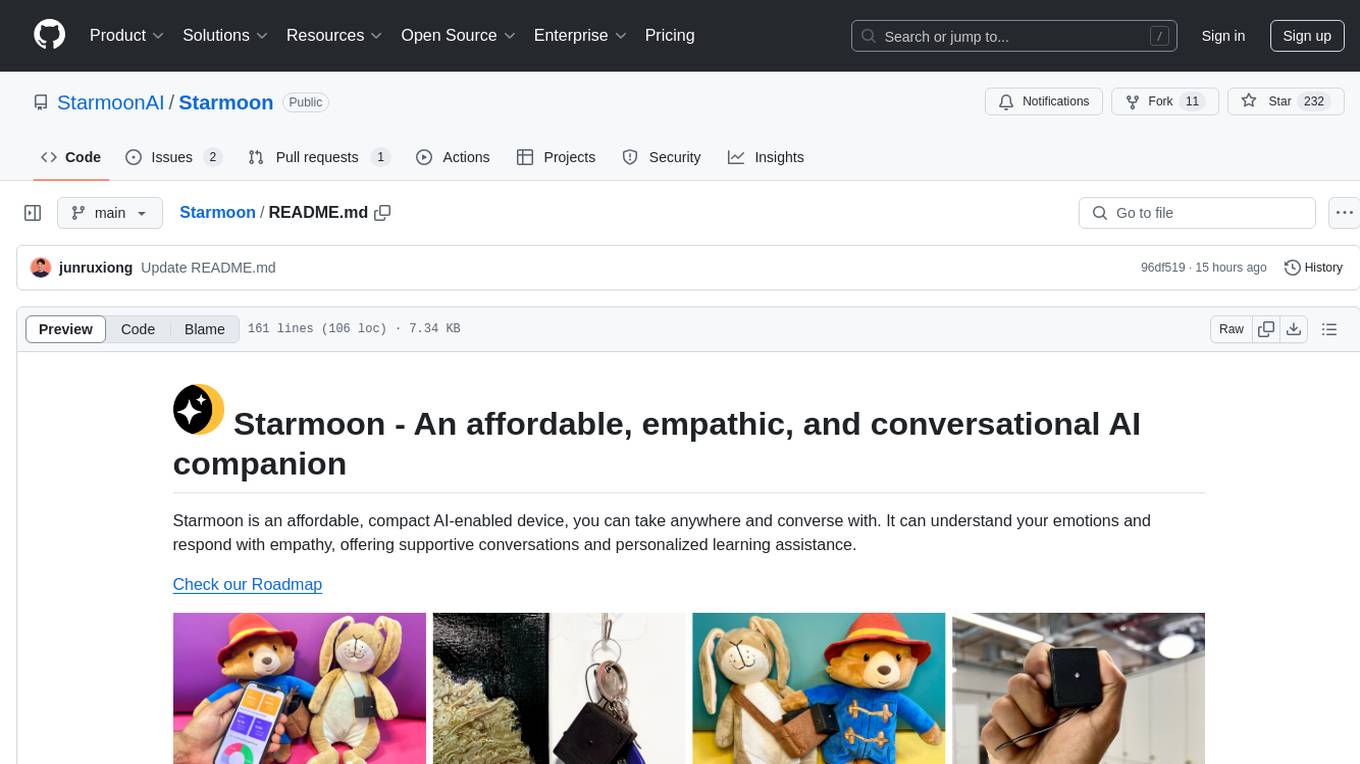
Starmoon
Starmoon is an affordable, compact AI-enabled device that can understand and respond to your emotions with empathy. It offers supportive conversations and personalized learning assistance. The device is cost-effective, voice-enabled, open-source, compact, and aims to reduce screen time. Users can assemble the device themselves using off-the-shelf components and deploy it locally for data privacy. Starmoon integrates various APIs for AI language models, speech-to-text, text-to-speech, and emotion intelligence. The hardware setup involves components like ESP32S3, microphone, amplifier, speaker, LED light, and button, along with software setup instructions for developers. The project also includes a web app, backend API, and background task dashboard for monitoring and management.
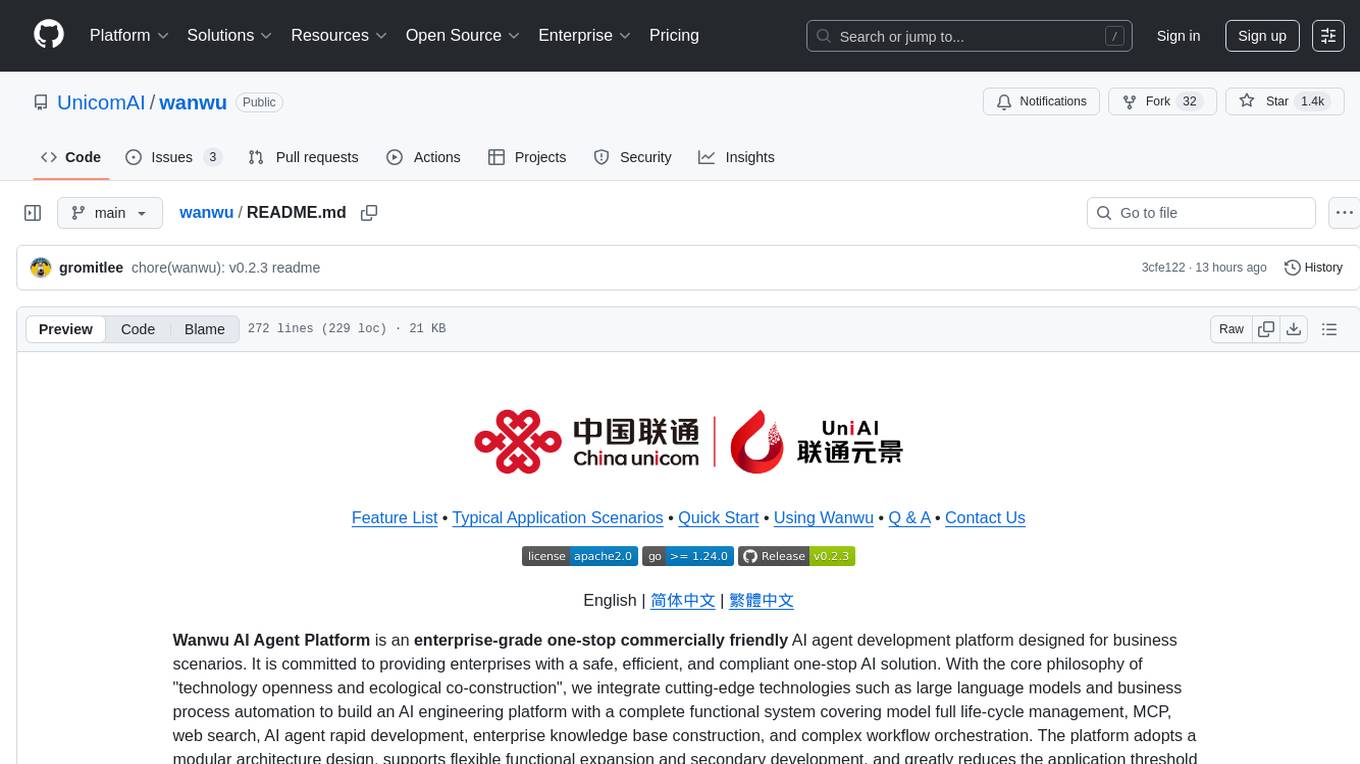
wanwu
Wanwu AI Agent Platform is an enterprise-grade one-stop commercially friendly AI agent development platform designed for business scenarios. It provides enterprises with a safe, efficient, and compliant one-stop AI solution. The platform integrates cutting-edge technologies such as large language models and business process automation to build an AI engineering platform covering model full life-cycle management, MCP, web search, AI agent rapid development, enterprise knowledge base construction, and complex workflow orchestration. It supports modular architecture design, flexible functional expansion, and secondary development, reducing the application threshold of AI technology while ensuring security and privacy protection of enterprise data. It accelerates digital transformation, cost reduction, efficiency improvement, and business innovation for enterprises of all sizes.
For similar tasks
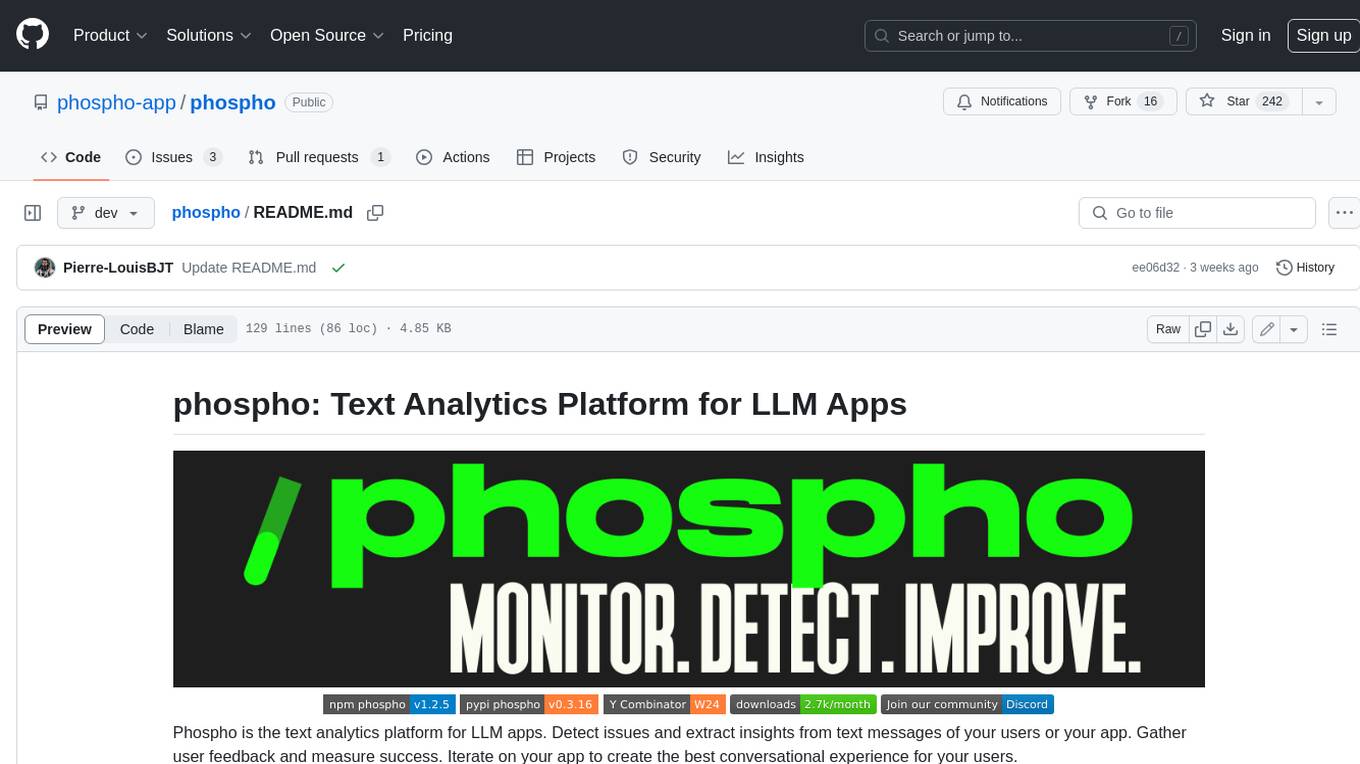
phospho
Phospho is a text analytics platform for LLM apps. It helps you detect issues and extract insights from text messages of your users or your app. You can gather user feedback, measure success, and iterate on your app to create the best conversational experience for your users.
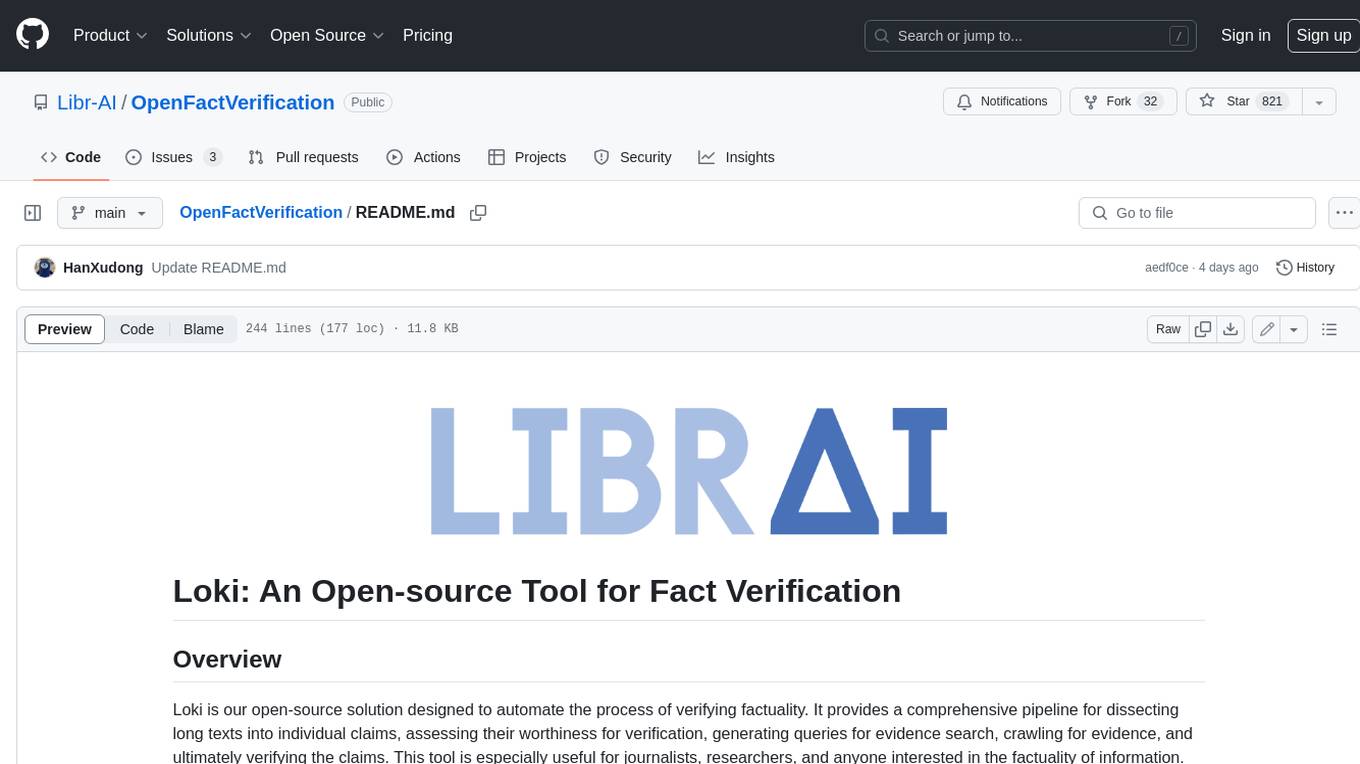
OpenFactVerification
Loki is an open-source tool designed to automate the process of verifying the factuality of information. It provides a comprehensive pipeline for dissecting long texts into individual claims, assessing their worthiness for verification, generating queries for evidence search, crawling for evidence, and ultimately verifying the claims. This tool is especially useful for journalists, researchers, and anyone interested in the factuality of information.
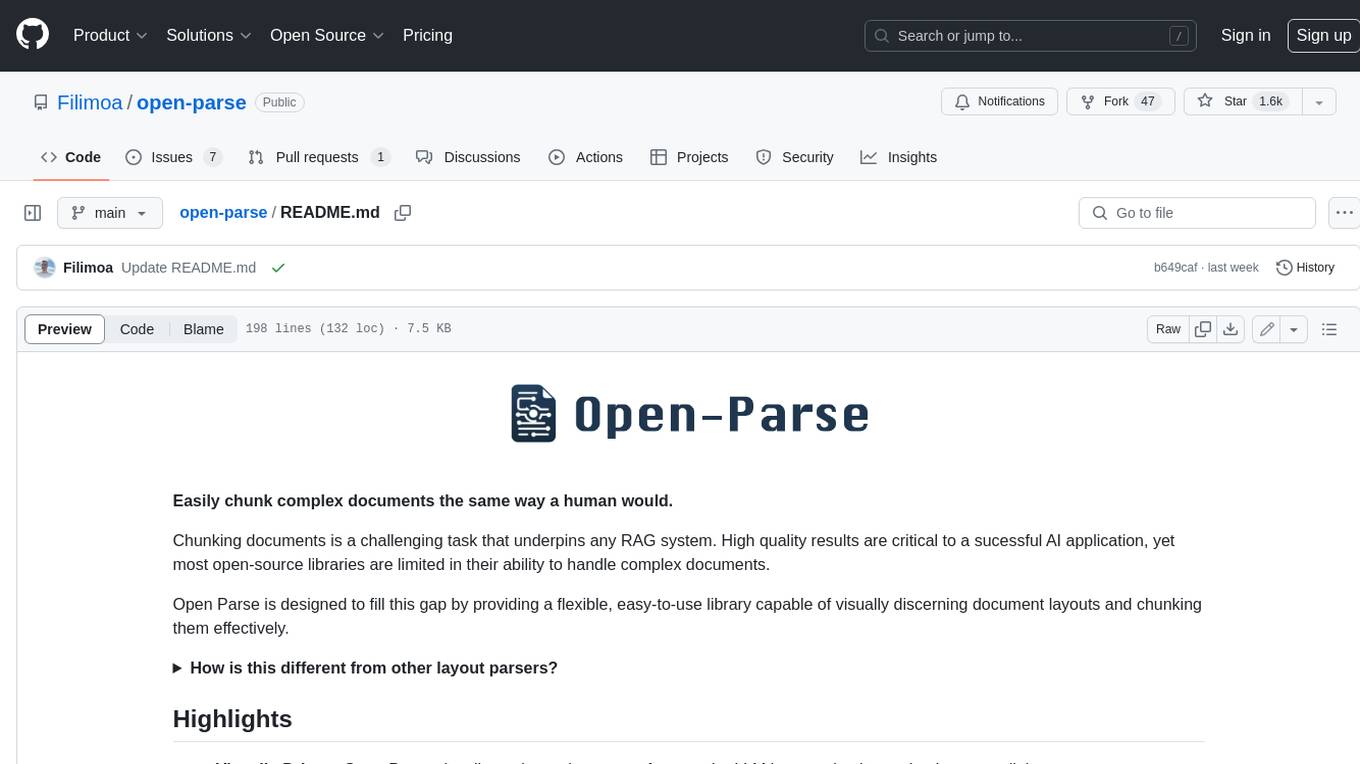
open-parse
Open Parse is a Python library for visually discerning document layouts and chunking them effectively. It is designed to fill the gap in open-source libraries for handling complex documents. Unlike text splitting, which converts a file to raw text and slices it up, Open Parse visually analyzes documents for superior LLM input. It also supports basic markdown for parsing headings, bold, and italics, and has high-precision table support, extracting tables into clean Markdown formats with accuracy that surpasses traditional tools. Open Parse is extensible, allowing users to easily implement their own post-processing steps. It is also intuitive, with great editor support and completion everywhere, making it easy to use and learn.

spaCy
spaCy is an industrial-strength Natural Language Processing (NLP) library in Python and Cython. It incorporates the latest research and is designed for real-world applications. The library offers pretrained pipelines supporting 70+ languages, with advanced neural network models for tasks such as tagging, parsing, named entity recognition, and text classification. It also facilitates multi-task learning with pretrained transformers like BERT, along with a production-ready training system and streamlined model packaging, deployment, and workflow management. spaCy is commercial open-source software released under the MIT license.

NanoLLM
NanoLLM is a tool designed for optimized local inference for Large Language Models (LLMs) using HuggingFace-like APIs. It supports quantization, vision/language models, multimodal agents, speech, vector DB, and RAG. The tool aims to provide efficient and effective processing for LLMs on local devices, enhancing performance and usability for various AI applications.
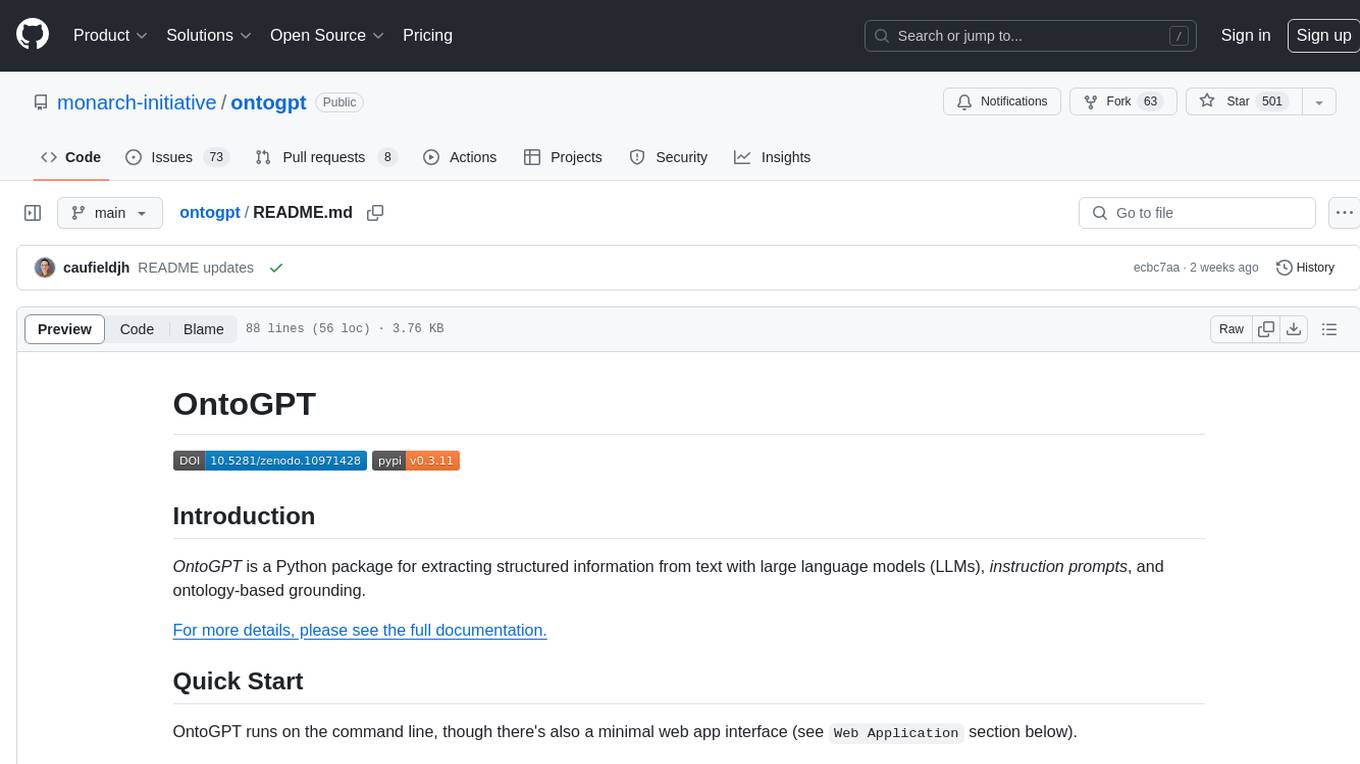
ontogpt
OntoGPT is a Python package for extracting structured information from text using large language models, instruction prompts, and ontology-based grounding. It provides a command line interface and a minimal web app for easy usage. The tool has been evaluated on test data and is used in related projects like TALISMAN for gene set analysis. OntoGPT enables users to extract information from text by specifying relevant terms and provides the extracted objects as output.
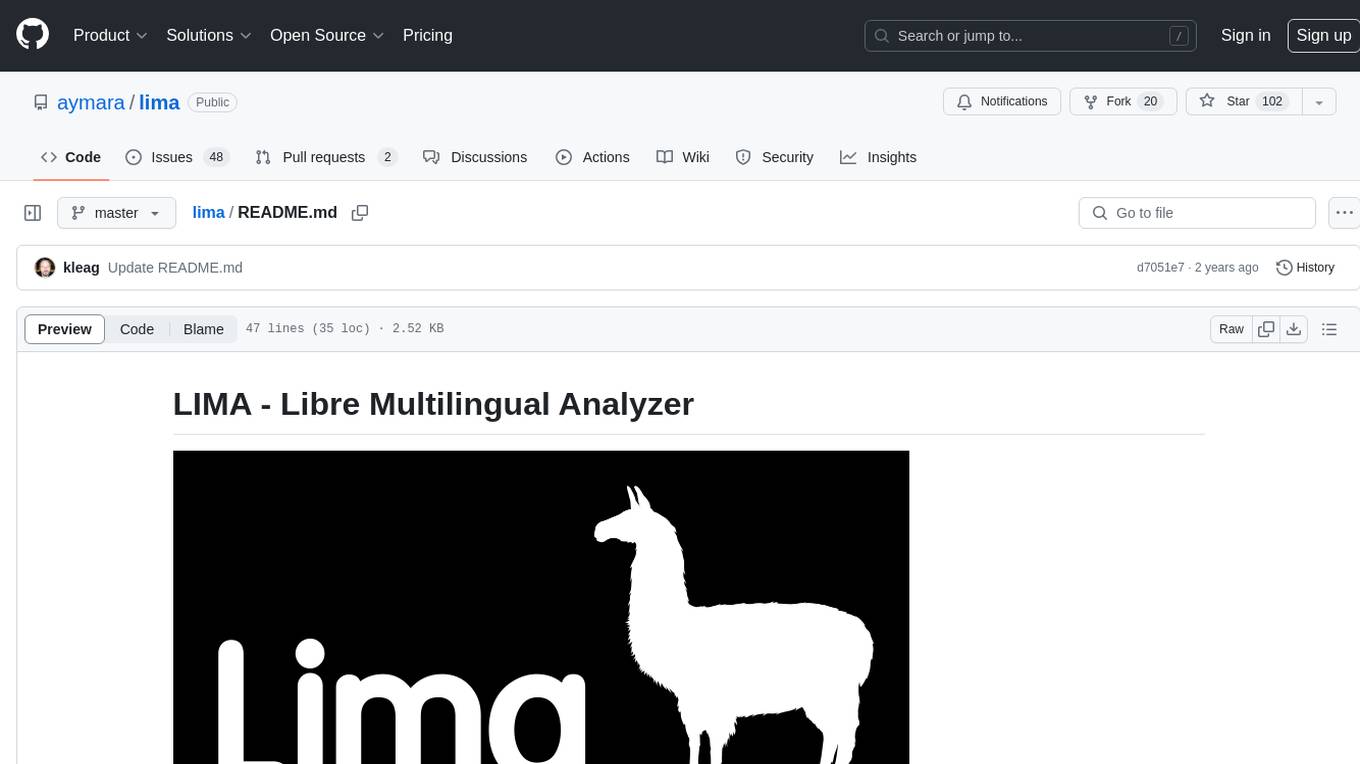
lima
LIMA is a multilingual linguistic analyzer developed by the CEA LIST, LASTI laboratory. It is Free Software available under the MIT license. LIMA has state-of-the-art performance for more than 60 languages using deep learning modules. It also includes a powerful rules-based mechanism called ModEx for extracting information in new domains without annotated data.
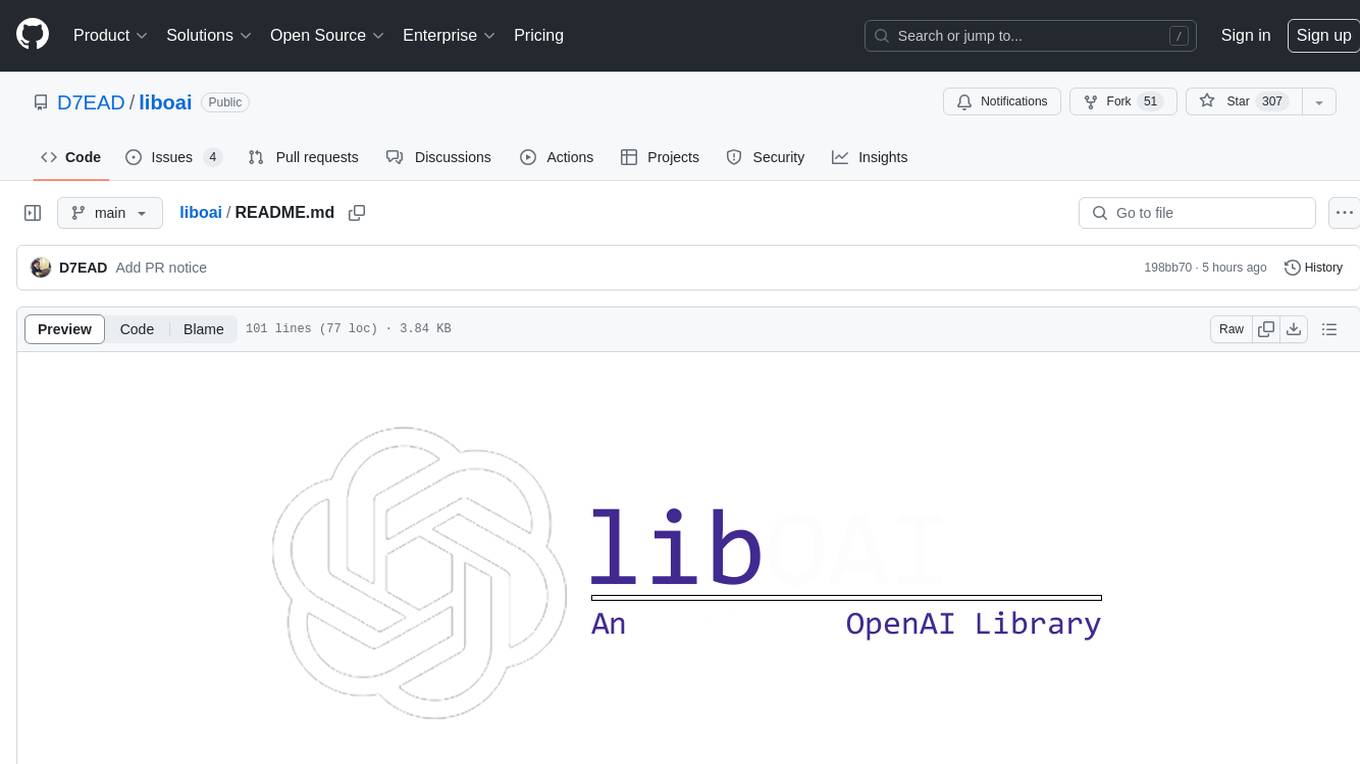
liboai
liboai is a simple C++17 library for the OpenAI API, providing developers with access to OpenAI endpoints through a collection of methods and classes. It serves as a spiritual port of OpenAI's Python library, 'openai', with similar structure and features. The library supports various functionalities such as ChatGPT, Audio, Azure, Functions, Image DALL·E, Models, Completions, Edit, Embeddings, Files, Fine-tunes, Moderation, and Asynchronous Support. Users can easily integrate the library into their C++ projects to interact with OpenAI services.
For similar jobs

weave
Weave is a toolkit for developing Generative AI applications, built by Weights & Biases. With Weave, you can log and debug language model inputs, outputs, and traces; build rigorous, apples-to-apples evaluations for language model use cases; and organize all the information generated across the LLM workflow, from experimentation to evaluations to production. Weave aims to bring rigor, best-practices, and composability to the inherently experimental process of developing Generative AI software, without introducing cognitive overhead.

LLMStack
LLMStack is a no-code platform for building generative AI agents, workflows, and chatbots. It allows users to connect their own data, internal tools, and GPT-powered models without any coding experience. LLMStack can be deployed to the cloud or on-premise and can be accessed via HTTP API or triggered from Slack or Discord.

VisionCraft
The VisionCraft API is a free API for using over 100 different AI models. From images to sound.

kaito
Kaito is an operator that automates the AI/ML inference model deployment in a Kubernetes cluster. It manages large model files using container images, avoids tuning deployment parameters to fit GPU hardware by providing preset configurations, auto-provisions GPU nodes based on model requirements, and hosts large model images in the public Microsoft Container Registry (MCR) if the license allows. Using Kaito, the workflow of onboarding large AI inference models in Kubernetes is largely simplified.

PyRIT
PyRIT is an open access automation framework designed to empower security professionals and ML engineers to red team foundation models and their applications. It automates AI Red Teaming tasks to allow operators to focus on more complicated and time-consuming tasks and can also identify security harms such as misuse (e.g., malware generation, jailbreaking), and privacy harms (e.g., identity theft). The goal is to allow researchers to have a baseline of how well their model and entire inference pipeline is doing against different harm categories and to be able to compare that baseline to future iterations of their model. This allows them to have empirical data on how well their model is doing today, and detect any degradation of performance based on future improvements.

tabby
Tabby is a self-hosted AI coding assistant, offering an open-source and on-premises alternative to GitHub Copilot. It boasts several key features: * Self-contained, with no need for a DBMS or cloud service. * OpenAPI interface, easy to integrate with existing infrastructure (e.g Cloud IDE). * Supports consumer-grade GPUs.

spear
SPEAR (Simulator for Photorealistic Embodied AI Research) is a powerful tool for training embodied agents. It features 300 unique virtual indoor environments with 2,566 unique rooms and 17,234 unique objects that can be manipulated individually. Each environment is designed by a professional artist and features detailed geometry, photorealistic materials, and a unique floor plan and object layout. SPEAR is implemented as Unreal Engine assets and provides an OpenAI Gym interface for interacting with the environments via Python.

Magick
Magick is a groundbreaking visual AIDE (Artificial Intelligence Development Environment) for no-code data pipelines and multimodal agents. Magick can connect to other services and comes with nodes and templates well-suited for intelligent agents, chatbots, complex reasoning systems and realistic characters.








